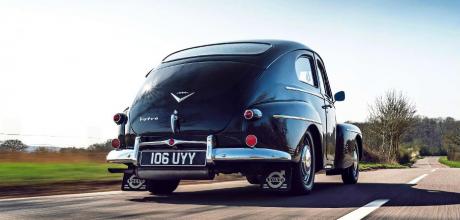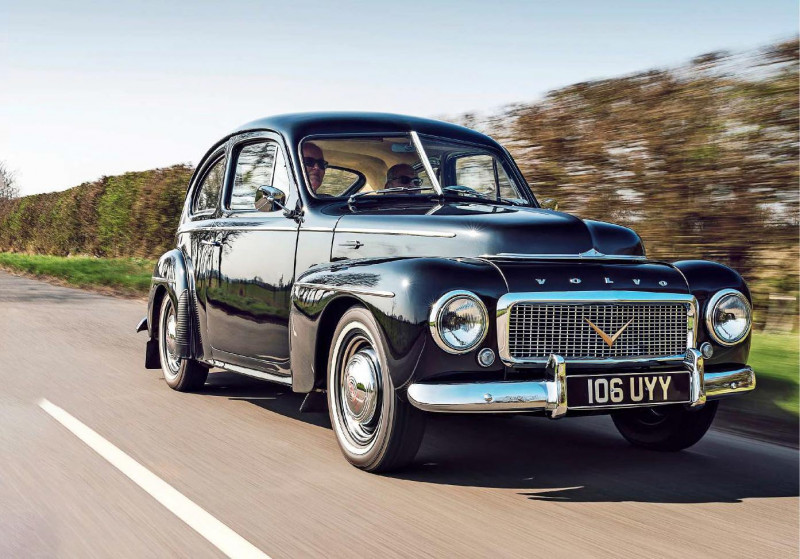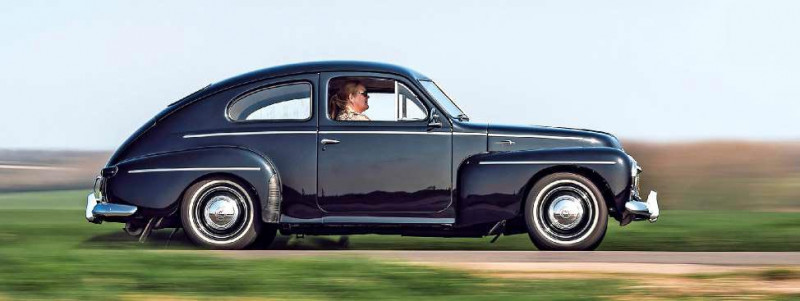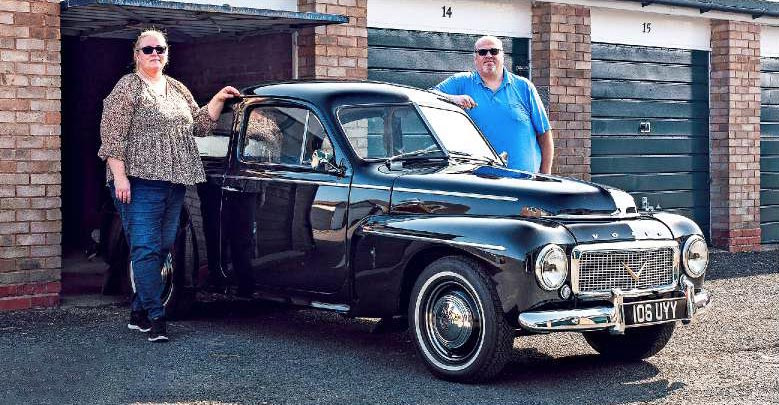Life Cycle 1958 Volvo PV444

In the same family since new, this Volvo is about to embark on itsnext journey – to the third country it’s called home
Words SAM DAWSON
Photos JORDAN BUTTERS
LIFE STORY OF A 1958 Volvo PV444
Life Cycle
1958 – The Olsen family buys a Volvo PV444
On 13 February 1958, brothers Gunnar and Olaf Olsen set off on a perilous and tragic snowbound two-hour bus journey from their hometown of Vest Agder, southern Norway, to the Volvo dealership in Kristiansand, to pick up a new PV444. ‘Back then, Norway operated a quotation system for certain goods including new cars, so there were waiting lists,’ says Gunnar’s daughter Ellen Olsen today. ‘It was a hangover from the Second World War, only came to an end in 1960, and made a lot of cars difficult to get hold of. Eastern European cars like Ladas were relatively easy to come by, but of the Western cars, the Volvos were the easiest to get hold of. There were two unallocated cars in the northern Norwegian district of Finmark, that had been reallocated down south, and uncle Olaf managed to jump the queue.’

The family’s promise of strong foreign currency may have helped, as Gunnar’s widow and Ellen’s mother Mary remembers. ‘Both Olaf and my own uncle Jakob were on the waiting list for a Volvo at the time, and US dollars were a big thing in Norway after the war. A lot of people from our district went to the US to work. Gunnar came back after a few years in the US with money to buy land and build a farm and outbuildings. But he didn’t have the kind of profession – doctor, police, firefighter – that would usually allow him to jump the queue and respond to cars being reallocated south. But dollars were sought-after, so they helped.’
‘Dad said, “I might sell it.” I replied, “You are not selling our Volvo!”’

Olaf met half of the cost of the new PV444 himself, with brother Gunnar and father Martin contributing a 25 percent share each; Olaf bought them both out later. ‘He was very selfless,’ says Ellen of her uncle Olaf. ‘He bought it because he wanted to give his parents, Martin and Lissi, the experience of getting out and about – they’d never had a car in the family before. But there was a problem – he didn’t have a driving licence. My Dad, however, did. He was a bus driver, so he would be the first person to drive the Volvo, picking it up from the dealership and chauffeuring everyone until Olaf passed his test.’ Gunnar recounted the fateful day the Volvo was collected to Ellen before he died in 2017. ‘It had been snowing so much, the bus needed a snowplough escort ahead of it to clear the road,’ says Ellen. ‘During the journey, the bus was held up while it waited for another snowplough to take over. Dad would later learn that the first snowplough had fallen off the road ahead of the bus, into a frozen lake, and the drivers had drowned. He knew them – they were colleagues from the bus station.’
Mary later discovered that her family had managed to obtain the other PV444 reallocated south. ‘My uncle and auntie, Jakob and Bertha Mikallsen, also had dollars from the US,’ she recalls. ‘They had three children working in America, and eventually they emigrated for good, but back then they were still helping the family, sending money back, and again this helped them jump the queue, because they didn’t have the professions needed to do that either – he worked on boats and she ran a shop.’

Even once Olaf passed his driving test, he didn’t actually need the car and correspondingly didn’t use it much, but it was in the family-runabout context that Ellen first encountered it. ‘It was mainly used for taking my grandparents out – that was it really. Picnics on Sunday afternoons, usually to a local beauty spot at Farsund, and family visits to places where it was too far to walk. I remember seeing it coming down the road to the house, knowing it as a sign that family was coming to visit.
‘When I was two years old, uncle Olaf married my auntie Borgny, and we took the Volvo on its longest drive – eight hours to Oslo – for the wedding. Dad was his best man. Dad and uncle Olaf sat up front, sharing the driving, Mum and auntie Borgny sat in the back with me on Borgny’s lap because Mum was pregnant at the time. On the way back from Oslo to Vest Agder, with the car full of wedding presents as well as the five of us, it picked up a puncture on the back corner of the car that I was sitting in. I’d been ill and they didn’t want to wake me, so Olaf and Gunnar jacked it up and changed the wheel as quietly as possible, with Borgny still sitting in the rear seat and me fast asleep on her lap!’
In 1970, the car’s pace of life changed, with Olaf pressing it into service as a daily driver. ‘He got a new job, in a pharmacy in Farsund,’ says Ellen. ‘The car was more than ten years old, an “old car” by then, and yet it still looked like new. Olaf kept it spotlessly clean, and would fill in a little book whenever he filled it with fuel.
Obviously Norway gets a lot of snow in winter, but so long as you keep a car clean they don’t rust like they do in the UK, because Norwegians use sand rather than salt to grit their roads. So the car never rusted. Even when it came to the UK, years later, it was still solid underneath. The only rust was on the wings.’ After a decade commuting to the pharmacy, Olaf’s next job took the Volvo a little further afield, to an aluminium plant near Farsund. However, after a few years of commuting, the Volvo finally let him down. ‘There was a problem with the engine – the water pump had seized,’ says Ellen. ‘He left it with a local mechanic to “take a look at it”, but it ended up there for two years! It was a very old car by that point – this was 1985 – so it wasn’t considered a priority. Olaf bought another car to replace it – another Volvo of course, a yellow 142 – and the PV444 ended up with a statutory off-road notification.
‘This was sad, because in Norway, cars lose their registration plates when they’re declared off the road, and need re-registering with a new plate when they’re put back on it,’ says Ellen. ‘This meant it no longer had a registration sequential with its dark blue sister car owned by Jakob and Bertha.
‘After the Volvo had spent a couple of years in the mechanic’s barn, and some more years sat in a field, Olaf passed away, and the mechanic returned the car to Borgny’s garage. Dad was given Olaf’s yellow 142.’
2014 – A new start?
‘Dad got the PV444 in 2014,’ says Ellen. By this point, it hadn’t turned a wheel in more than 20 years, and Ellen was living in Coventry. ‘Although it wasn’t running, auntie Borgny was reluctant to let it go, partly because it reminded her of Olaf, but she also wanted something to occupy the garage. Her neighbours knew she didn’t have any use for her garage, were keen to use it, and she knew they’d ask as soon as they knew it was empty.
‘Dad had an old trailer in his garage that he wasn’t doing anything with, so he swapped it for the Volvo, keeping Borgny’s garage occupied in the process. ‘Dad really wanted to restore the PV444, but in 2016 he admitted to me over the phone that he didn’t have the health to see it through, and said, “I might sell it.” I replied “You are not selling our Volvo!” I then went upstairs to my partner Nick and said, “Dad’s getting rid of the Volvo, can we have it?” I knew at the time I didn’t have the skills to restore it myself, so I needed his help. He’s good at working on old engines, and I figured I could learn. He said, “Yes, of course!” – he didn’t want to see it leave the family. ‘So, we knew we were going to take it on, but we weren’t in a rush. In 2017, a friend of ours, Alastair May, trailered it over from Norway. But it wasn’t a straightforward journey. In order to make the trip pay, Alastair took a two-car flatbed and delivered other cars from country to country. His trip took him from Norway to Sweden, then Finland, Estonia, Germany, France, back to Germany again, then the Netherlands, and over the sea to England.
‘The Volvo was delivered to Nick’s house in Coventry, because he had a garage – the place I was living in only had a parking space at the time, but it sat there for another four years while Nick sold the house and we moved to Stratford-upon-Avon. ‘Nick’s brother-in-law recommended Crabmill Autos give it a mechanical check-over before we began the restoration. A service revealed that the fuel lines and water pump still required replacing, a straightforward job, but the bodywork needed restoration. We cast around for quotes, one specialist quoted £82,000 – I replied, “it’s not a DB5!” – but Nick’s nephew had had some work done on his Volkswagen Camper at Cars to Go in Coventry at a reasonable price. A guy called Marian came to check the car out, and admitted that they usually repair accident damage, but they would address the bodywork affordably between more urgent jobs.’
Addressing the car’s mechanical parts was a poignant experience for Ellen. ‘When the car arrived from Norway, it came with a big box full of jam jars and little boxes,’ she says. ‘Each one carried a handwritten note from Dad explaining what was in it and what part of the car it had come off. I was quite emotional as we’d just lost him, but it was so typical of him, so organised – so Dad – that he was still helping us with the Volvo even though he was no longer with us. It made it easy to realise what parts we had, which couldn’t be saved, and which ones we needed. In the meantime, Cars to Go had completed the bodywork restoration and respray, including welding in the corners of the bodyshell. Coventry-based trimmer Nabeel Hussain restored the interior, being careful to retain the worn grab handles I remember holding as a child. The restoration was finally completed in May 2021. We picked it up on a Thursday to take it to the Evesham Steam Rally on the Friday, only to find that it had no radiator grille! ‘We still took it to the show though. A lot of people have never seen a PV444 so we always get a good response. We managed to get hold of a new grille and surround in time for its next show, the Coventry MotoFest Meet, and then its biggest show to date, the Practical Classics Restoration Show at the NEC. It’s an example of a nice restoration rather than a nut-and- bolt rebuild. We only replaced what was needed.
‘And now, it’s off to a new life in Portugal! We fell in love with Portugal on holiday nine years ago, went for six years, then bought a place out there, and I’ve got a job there. We are in the Volvo Enthusiasts’ Club, and they don’t have a representative in Portugal, so we will start up a group and set up meets and events for old cars in general and Volvos in particular. It will be the third country our PV444 has lived in – fourth if you count the factory in Sweden where it was made.’
‘We cast around for quotes, one specialist quoted £82,000 – I replied, “it’s not a DB5!”’ Seized water pump put the Volvo off the road for 37 years Ellen and Nick will set up a Portuguese Volvo owners’ club Ellen’s early memories are as a passenger – now the Volvo is hers Basket and rug a reminder of duties in Volvo’s first decade [ Life Cycle] Volvo PV444 Know your classic’s previous owners? Let us know at ADMIN@DRIVES.TODAY and it might make for one of our features
Ellen wouldn’t let the Volvo leave the Olsen family after 60 years 2021: masked for respray at Cars to Go
Oil and battery have same spellings in Swedish and Norwegian 2017: the Volvo leaves Norway, on an epic trip across Europe 2017: rusty wings, but not bad for a car that spent 30 years static Cruising the roads of Warwickshire that it’s briefly called home 2021: bodily sound; only the wings needed serious attention 2022: at MotoFest Meet in Coventry, its first show in a complete state.
Restored interior preserves Ellen’s early memories 1958: Olaf Olsen tries his new PV444 for size
By the time you read this, the Volvo will be living in Portugal 2014: Gunnar takes on the dormant car 1960s: Olaf, Lissi and Martin on a day out to Farsund

